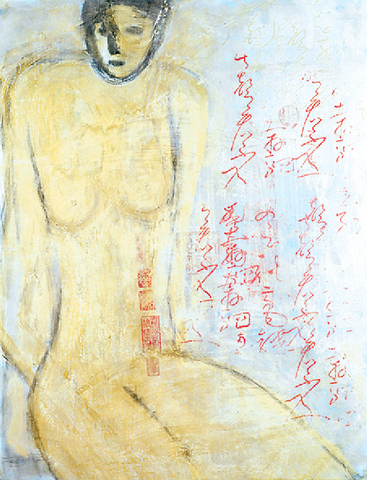The farewell party for Club 75 yesterday marked the end of Patrick Lee's (李紹榮) days as a club proprietor, freeing up his schedule to pursue art full time. Only a few hours before he closed the bar on Saturday night Lee held an opening for his latest solo exhibition, Simply Symbols at Jeff Hsu's gallery in Taipei.
He studied finance at University and worked in the bar and restaurant industry for over a decade. Never formally trained in art, Lee has been painting since he was 10 years old. Although he treats it more like a hobby, his work generates a sizeable revenue. It is especially popular in Europe where his most recent exhibit at a gallery in Copenhagen, Denmark sold every piece.
The 25 works on display are a continuation of a style Lee has been working with in the last five years. In his words it's a combination of "east and west." In this case the east is illustrated by calligraphy and Chinese symbols while the nude female silhouettes represent the west, or more accurately the western influence on his work.

PHOTO COURTESY OF THE ARTIST
The ink stokes used to paint the female figure and the choice of red, black, white and gold colors are characteristic of Chinese brush painting. The calligraphy and chop markings that cover the body compliment the figure. A few of the images invoke memories of Peter Greenaway's The Pillow Book, in which a woman seeks lovers who will use her body like a canvas to write on. The women in Lee's paintings are often without any facial features, and sometimes even without heads. The anonymity gives them a nondescript yet indisputably feminine shape.
The larger pieces are completed on canvases while the smaller pieces use a wooden surface. Both utilize acrylic and oil paints together with metallic powder, silk-screening and calligraphy. The combination is not excessive and the paintings retain a minimalist appearance. The layers of materials create depth and texture, which is more visible in the wooden canvases.
Lee's new work is a major departure from his earlier paintings in the early 1990s that focused on abstract western landscapes. The introduction of Chinese motifs into his work is more recent. Neither the symbols nor the images are imbedded with hidden explanations, according to Lee, who described them as a blend of Chinese and European influences. "There are simply symbols with no hidden meaning," he said.
Each of the works is aesthetically pleasing to look at on its own, but overall the exhibition has a commercial feel. Strong impressions from an individual painting are weakened by the fact that there are 20 other similar ones surrounding it.
What is exceptional, however, is the way Lee made use of the space. An otherwise plain cement room has been transformed with a few Buddhist relics and four large standing red lamp tables to look like a lounge bar. It's possible to assess how and why these artworks would be popular in a club space. Likewise, it's easy to see Lee's interest and eye for interior design.
Exhibition notes:
What: `Simply Symbols: The Solo Exhibition of Patrick Lee'
Where: Jeff Hsu's Art (
Telephone: (02) 8780 8181
When: The exhibition runs until March 27. The gallery is open daily from 11am to 7pm but closed on Mondays.

May 11 to May 18 The original Taichung Railway Station was long thought to have been completely razed. Opening on May 15, 1905, the one-story wooden structure soon outgrew its purpose and was replaced in 1917 by a grandiose, Western-style station. During construction on the third-generation station in 2017, workers discovered the service pit for the original station’s locomotive depot. A year later, a small wooden building on site was determined by historians to be the first stationmaster’s office, built around 1908. With these findings, the Taichung Railway Station Cultural Park now boasts that it has

Wooden houses wedged between concrete, crumbling brick facades with roofs gaping to the sky, and tiled art deco buildings down narrow alleyways: Taichung Central District’s (中區) aging architecture reveals both the allure and reality of the old downtown. From Indigenous settlement to capital under Qing Dynasty rule through to Japanese colonization, Taichung’s Central District holds a long and layered history. The bygone beauty of its streets once earned it the nickname “Little Kyoto.” Since the late eighties, however, the shifting of economic and government centers westward signaled a gradual decline in the area’s evolving fortunes. With the regeneration of the once

The latest Formosa poll released at the end of last month shows confidence in President William Lai (賴清德) plunged 8.1 percent, while satisfaction with the Lai administration fared worse with a drop of 8.5 percent. Those lacking confidence in Lai jumped by 6 percent and dissatisfaction in his administration spiked up 6.7 percent. Confidence in Lai is still strong at 48.6 percent, compared to 43 percent lacking confidence — but this is his worst result overall since he took office. For the first time, dissatisfaction with his administration surpassed satisfaction, 47.3 to 47.1 percent. Though statistically a tie, for most

In February of this year the Taipei Times reported on the visit of Lienchiang County Commissioner Wang Chung-ming (王忠銘) of the Chinese Nationalist Party (KMT) and a delegation to a lantern festival in Fuzhou’s Mawei District in Fujian Province. “Today, Mawei and Matsu jointly marked the lantern festival,” Wang was quoted as saying, adding that both sides “being of one people,” is a cause for joy. Wang was passing around a common claim of officials of the People’s Republic of China (PRC) and the PRC’s allies and supporters in Taiwan — KMT and the Taiwan People’s Party — and elsewhere: Taiwan and